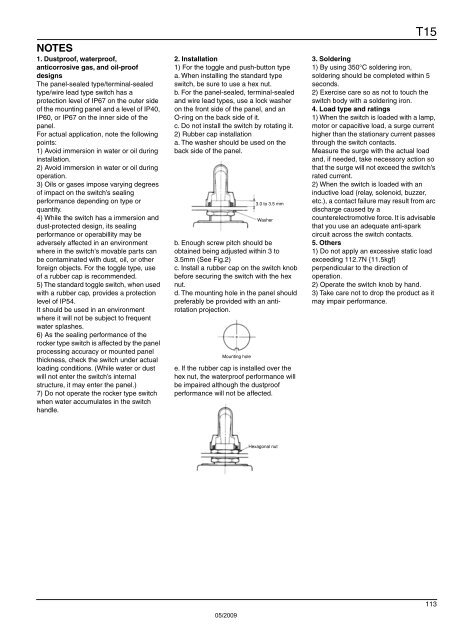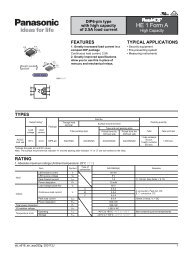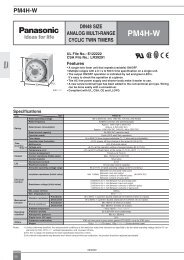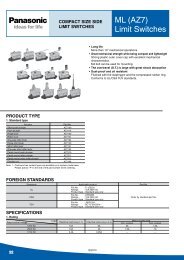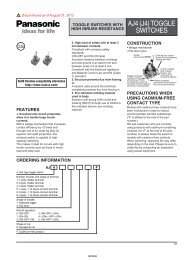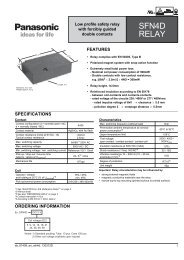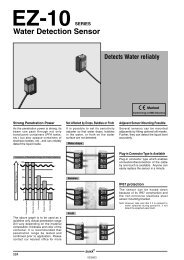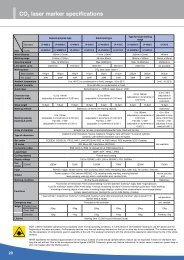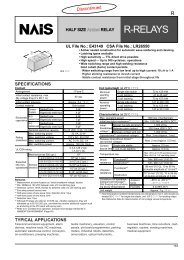T A B L E O F C O N T E N T S - Panasonic Electric Works Europe AG
T A B L E O F C O N T E N T S - Panasonic Electric Works Europe AG
T A B L E O F C O N T E N T S - Panasonic Electric Works Europe AG
You also want an ePaper? Increase the reach of your titles
YUMPU automatically turns print PDFs into web optimized ePapers that Google loves.
NOTES<br />
1. Dustproof, waterproof,<br />
anticorrosive gas, and oil-proof<br />
designs<br />
The panel-sealed type/terminal-sealed<br />
type/wire lead type switch has a<br />
protection level of IP67 on the outer side<br />
of the mounting panel and a level of IP40,<br />
IP60, or IP67 on the inner side of the<br />
panel.<br />
For actual application, note the following<br />
points:<br />
1) Avoid immersion in water or oil during<br />
installation.<br />
2) Avoid immersion in water or oil during<br />
operation.<br />
3) Oils or gases impose varying degrees<br />
of impact on the switch’s sealing<br />
performance depending on type or<br />
quantity.<br />
4) While the switch has a immersion and<br />
dust-protected design, its sealing<br />
performance or operabillity may be<br />
adversely affected in an environment<br />
where in the switch's movable parts can<br />
be contaminated with dust, oil, or other<br />
foreign objects. For the toggle type, use<br />
of a rubber cap is recommended.<br />
5) The standard toggle switch, when used<br />
with a rubber cap, provides a protection<br />
level of IP54.<br />
It should be used in an environment<br />
where it will not be subject to frequent<br />
water splashes.<br />
6) As the sealing performance of the<br />
rocker type switch is affected by the panel<br />
processing accuracy or mounted panel<br />
thickness, check the switch under actual<br />
loading conditions. (While water or dust<br />
will not enter the switch’s internal<br />
structure, it may enter the panel.)<br />
7) Do not operate the rocker type switch<br />
when water accumulates in the switch<br />
handle.<br />
2. Installation<br />
1) For the toggle and push-button type<br />
a. When installing the standard type<br />
switch, be sure to use a hex nut.<br />
b. For the panel-sealed, terminal-sealed<br />
and wire lead types, use a lock washer<br />
on the front side of the panel, and an<br />
O-ring on the back side of it.<br />
c. Do not install the switch by rotating it.<br />
2) Rubber cap installation<br />
a. The washer should be used on the<br />
back side of the panel.<br />
b. Enough screw pitch should be<br />
obtained being adjusted within 3 to<br />
3.5mm (See Fig.2)<br />
c. Install a rubber cap on the switch knob<br />
before securing the switch with the hex<br />
nut.<br />
d. The mounting hole in the panel should<br />
preferably be provided with an antirotation<br />
projection.<br />
Mounting hole<br />
3.0 to 3.5 mm<br />
Washer<br />
e. If the rubber cap is installed over the<br />
hex nut, the waterproof performance will<br />
be impaired although the dustproof<br />
performance will not be affected.<br />
T15<br />
3. Soldering<br />
1) By using 350°C soldering iron,<br />
soldering should be completed within 5<br />
seconds.<br />
2) Exercise care so as not to touch the<br />
switch body with a soldering iron.<br />
4. Load type and ratings<br />
1) When the switch is loaded with a lamp,<br />
motor or capacitive load, a surge current<br />
higher than the stationary current passes<br />
through the switch contacts.<br />
Measure the surge with the actual load<br />
and, if needed, take necessory action so<br />
that the surge will not exceed the switch’s<br />
rated current.<br />
2) When the switch is loaded with an<br />
inductive load (relay, solenoid, buzzer,<br />
etc.), a contact failure may result from arc<br />
discharge caused by a<br />
counterelectromotive force. It is advisable<br />
that you use an adequate anti-spark<br />
circuit across the switch contacts.<br />
5. Others<br />
1) Do not apply an excessive static load<br />
exceeding 112.7N {11.5kgf}<br />
perpendicular to the direction of<br />
operation.<br />
2) Operate the switch knob by hand.<br />
3) Take care not to drop the product as it<br />
may impair performance.<br />
Hexagonal nut<br />
05/2009<br />
113


